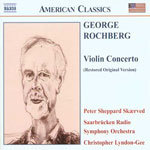
Violin Concerto (restored original version)
 $25.00
Out of Stock
$25.00
Out of Stock6+ weeks add to cart
GEORGE ROCHBERG
Violin Concerto (restored original version)
Peter Sheppard Skaerved (violin) / Saarbrucken Radio Symphony Orchestra / Christopher Lyndon-Gee (conductor)
[ Naxos American Classics / CD ]
Release Date: Friday 2 April 2004
This item is currently out of stock. It may take 6 or more weeks to obtain from when you place your order as this is a specialist product.
"The Rochberg concerto is a powerful work with music of grit and emotionally fluency sustained across five meaty movements. It stands alongside the superb William Schuman concerto (also recorded by Naxos) as one of the finest concerted works by an American composer. Who knows, Naxos may yet, at this rate, give us the orchestral works of Ronald Stevenson which also include a Violin Concerto of similar dimensions and impact."
(MusicWeb July 2007)
George Rochberg was born in Paterson, New Jersey on 5th July, 1918. An accomplished pianist who worked his way through college playing in jazz bands in New York City, he began formal studies of composition in 1939 at the Mannes School of Music under Hans Weisse, George Szell and Leopold Mannes. He was seriously wounded during wartime service in Europe, subsequently resuming his studies at the Curtis Institute of Music in Philadelphia in 1945 with Rosario Scalero. From 1951 he was Director of Publications for the music publishing house Theodore Presser, in 1960 becoming Chairman of the Music Department at the University of Pennsylvania. In 1979 he was designated Annenberg Professor of the Humanities, retiring from the University in 1983.
Rochberg's music has been honoured since his earliest substantial compositions, his Night Music receiving the George Gershwin Memorial Award in 1953. Since then, Naumberg Recording Awards, Guggenheim Fellowships, Honorary Doctorates, a Fellowship at the American Academy in Rome, and Fulbright Scholarship in 1950-51 (the year in which he met and befriended Luigi Dallapiccola), the ASCAP Lifetime Achievement Award in 2000, and countless other honours have accumulated in ever greater profusion. In 1996 his manuscripts and papers were acquired for the archives at the Paul Sacher Foundation in Basel, Switzerland.
The key that will open George Rochberg's music to the willing, the curious, but especially to the "innocent" ear, lies not in the conventional wisdom that declares him the first "post modernist" for his openness to a complex mix of musical languages, but rather in seeking to enter the composer's extraordinary understanding of the nature of time.
As long ago as 1963, Rochberg, in The New Image of Music, wrote that the successive revolutions of twelve-tone composition and of the post-war avant-garde had brought about a liberation that "permits sounds to create their own context". This liberation of sound from tonal harmonic functions, led to "the overthrow of a long-dominant temporal structure"; to a world in which conglomerates of pure sound are able to interact in ways that are not necessarily hidebound by structural considerations.
"Subjective man," writes Rochberg, "views existence as change; himself and his history at the center of a process of becoming.. Subjective man cannot transcend time; he is trapped in it. However, when man seizes on the present moment of existence as the only 'real' time, he spatializes his existence; that is, he fills his present with objects that take on … a state of permanence." Thus did the composer allow broader means of expression to be added to his vocabulary, constantly enlarging it, making possible what he later came to call an "all-at once world".
By 1959, Rochberg was lionized as America's first and greatest master of composition in a serial language. His 1955-56 Second Symphony, taken up and enthusiastically given its première by George Szell, seemed to lay out a path for him as one of the leaders of the American avant-garde, and yet, not even three years after its première, he was rethinking his language, already dissatisfied with the limitations of expressivity of the strict twelve-tone environment. Having mastered the idiom, he was far ahead of his time in seeking to go beyond it.
The oft-repeated assertion that it was predominantly personal tragedy that led Rochberg to abandon dodecaphony and embrace tonality, is not entirely borne out by the facts. His evolution towards a multiplicity of simultaneous languages was already well in train from his earliest compositions. Rochberg speaks of his use of twelve-tone techniques as engendering a "hard" Romanticism (kin, perhaps, to the works of Alban Berg) - one has only to look at the slow movement of the Second Symphony, Rochberg's "serial" work par excellence, to see that the tone row yields music that alternates between melting, elegiac beauty and desperate explosions of anguish, ebullient self-confidence and profound tragedy. George Rochberg's relationship with the past is thus not one of nostalgia: it is one of intimate, living familiarity. Indeed, he has said, in Reflections on the Renewal of Music, "History will not help us; but the past, which is ever-present, can". One recalls, too, William Faulkner's dictum : "the past - it is not even past!"
Rochberg is never about regret, borrowing or quotation (even if only quotation "in kind"). The Universal Mind, which is there to be embraced by a composer humble enough to deny ego and the flawed search for "originality" at all costs, transcends Time and Space. Denying individualism, seeing the creative artist as a representative of the endless procession of the human condition, the purveyor of our collective memory, allows the composer to gather the entirety of experience into a single, integrated language. "The hope of contemporary music", writes Rochberg, "lies in learning how to reconcile all manner of opposites, contradictions, paradoxes; the past with the present, tonality with atonality. That is why, in my most recent music, I have tried to utilize these in combinations which reassert the primal values of music."
Tracks:
Violin Concerto
01. Introduction 06:53
02. Intermezzo A 08:07
03. Fantasia 07:39
04. Intermezzo B 18:35
05. Epilogue 10:26

